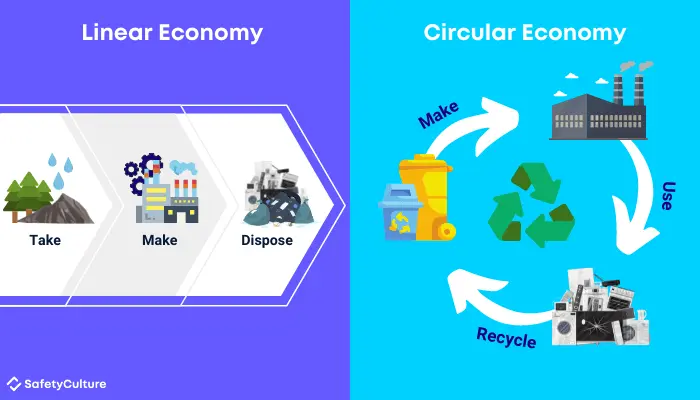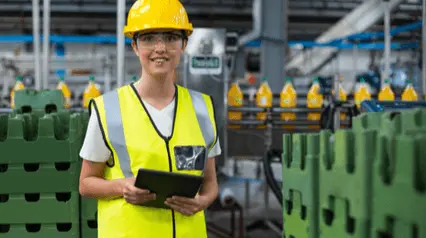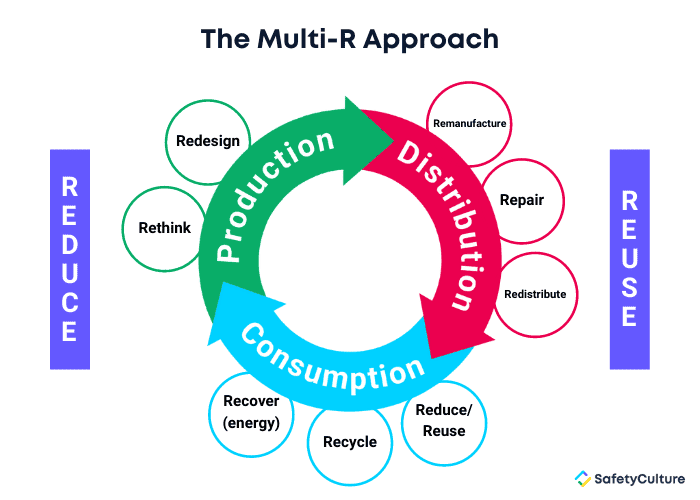Circular Economy (CE) Definition
The optimal use and reuse of resources in the various stages throughout production chains—from the extraction of raw resources all the way to consumption—is the core of Circular Economy. This is a systematic solution to reducing waste from being created in the first place. The reuse of goods and raw materials, as well as the reduction of waste and toxic emissions to soils, water, and air, are central to CE.
The World Economic Forum’s Definition of Circular Economy
“A circular economy is an industrial system that is restorative or regenerative by intention and design. It replaces the end-of-life concept with restoration, shifts towards the use of renewable energy, eliminates the use of toxic chemicals, which impair reuse and return to the biosphere, and aims for the elimination of waste through the superior design of materials, products, systems, and business models.”
Ellen McArthur Foundation’s Definition of Circular Economy
“Looking beyond the current take-make-dispose extractive industrial model, a circular economy aims to redefine growth, focusing on positive society-wide benefits. It entails gradually decoupling economic activity from the consumption of finite resources and designing waste out of the system. Underpinned by a transition to renewable energy sources, the circular model builds economic, natural, and social capital. It is based on three principles: design out waste and pollution; keep products and materials in use; regenerate natural systems.”
Linear Economy vs Circular Economy
We take materials from the Earth, create products from them, and then discard them as waste, this process is known as linear economy. A circular economy, as contrast to a linear economy, makes the most efficient use of raw materials and resources.

Linear Economy vs Circular Economy | SafetyCulture
Take-Make-Dispose Model
It follows a “take-make-dispose” pattern, making unbounded use of resources to produce products that will just be thrown away after use. Each time we do this, we are consuming large amounts of finite supply of resources and continuously generating waste—including toxic waste—that we are now struggling to properly manage. This is not sustainable in the long run.
Because of the growing global population, consumption is also increasing, driving resources at risk of becoming scarce. As a result, it is becoming increasingly important to make the most efficient use of available resources.
Make-Use-Recycle Loop
On the other hand, a circular economy follows a loop cycle. This means that materials and resources will continue to be used in a way that maximizes economic value while minimizing environmental harm.
Three Elements in Understanding Circular Economy (CE)
A circular economy is a closed-loop economic system in which raw materials, components, and products lose as little value as possible, renewable energy sources are utilized, and systems thinking is emphasized.
- Closed Loop Cycles
Material cycles are closed in a circular economy, following the example of an ecosystem. Because every residual stream can be used to create a new product, there is no such thing as waste. Toxic compounds are removed, and residual flows are divided into two cycles: biological and technological. Producers return their items after they have been used and repair them so that they can be used again. It is therefore important in this system that not only materials are properly recycled, but also that products, components, and raw materials maintain high quality throughout these cycles. - Renewable Energy
In a circular economy, the use of energy, like raw materials and products, is optimized. Renewable energy sources primarily power the circular economic system. - Systems Thinking
Not only does the circular economy need closed material cycles and sustainable energy, but it also involves systems thinking. Every economic actor (firm, individual, or species) is linked to others. This creates a network in which one actor’s actions have an impact on other actors. To account for this, short and long-term effects, as well as the impact of the entire value chain, must be considered when making transitions.
Linear to Circular Economy: Rethinking System
The transition from a linear to a circular economy involves system changes. Designs or processes, items that can be repaired or renewed, material recycling, and a new way of thinking about products (for example, sharing them) are all aspects involved in such a transition.
Sustainable Innovation
Innovative solutions based on a new way of thinking are encouraged by the circular economy. That implies thinking in terms of circular rather than linear value chains and aiming for system-wide innovations. This leads to fresh ideas and collaboration between designers, manufacturers, and recyclers, resulting in long-term breakthroughs.
Multi R-Approach
Prioritizing strategies according to the R’s is a good rule of thumb for finding the greatest value resource throughout the cycle.
- Rethink and reduce – By changing the way we think about products and manufacturing processes, and finding ways on how we can optimize what we have, we can use resources more efficiently.
- Redesign – Design in a different way, for example, by thinking about reuse, repair, and recycling options prior to starting the production.
- Reuse – maximum reuse of products and components.
- Repair and remanufacturing – Product repair, maintenance and revision.
- Recycling – reusing raw materials to its maximum quality
- Recover – Recover energy from materials.
Digitize the way you Work
Empower your team with SafetyCulture to perform checks, train staff, report issues, and automate tasks with our digital platform.
Get Started for FreeCircular Economy Benefits
The Circular Economy shows consistency in decreasing material life cycle impacts, such as climate impacts, limiting the use of toxic materials, and decoupling material consumption from economic growth.
Economic Benefits
Circularity has a number of economic benefits. More effective resource management would save the global economy $2 trillion per year. This is because raw material costs will decrease dramatically, resulting in increased employment and innovation. As a result, businesses will not be constrained in their ability to expand due to a scarcity of raw materials. The transition to a circular economy is thought to boost economic growth.
Material cost reduction
Companies are cutting material costs and generating whole new markets where profits can be made as a result of the move to the circular economy. Raw materials are a high-cost commodity in many industries. In a linear economy, the extraction of additional raw materials and the uncertainty about their supply drives up the price of these materials.
As a result of decreased costs, increased raw material supply security, tighter chain cooperation, and a more robust supply chain, circularity might offer new revenue potential.This is how businesses interact with their customers and the role they play in their lives—less raw materials are used, less waste is generated, and manufacturing is modified.
Environmental Benefits
The circular economy is an industrial model that is intended and designed to be regenerative, with the goal of improving resource management and combating the volatility that climate change may bring to businesses. The circular economy is a systems solution framework that tackles global challenges like:
- Climate Change
- Biodiversity Loss
- Waste Management
- Pollution
Compliance
Two of the most pressing emerging APAC (Asia-Pacific) issues are Rapid Urbanizations and Environmental Challenges. Climate change, combined with rapid population growth and urbanization, are placing intense pressure on Asia’s most precious resources.
Governments and global organizations are working to find a new approach and solution for issues stemming out of the linear economy. Adapting to circular economy would be an advantage for organizations because, sooner or later, governments may actively seek cooperation with businesses in order to thoroughly sustain a circular economy.
The circular economy model offers a new chance at innovation and integration between natural ecosystems, businesses, consumers, and waste management.
Circular Economy Sustainability
Many natural resources were extracted and have become part of infrastructure and manufactured into everyday things. Certain common items, such as paper, steel, and glass, are recycled in large numbers.
There are a variety of materials and products that are currently thrown away but might have been reused had the basic components been recovered. Discarded electronic gadgets, for example, include numerous rare earth metals and precious metals that are currently rarely recycled.
Integrate ESG principles into your operations
Drive sustainable growth and create long-term value with our ESG solutions.
Explore nowCircular Economy Examples
Two helpful strategies that can be done as we transition to a circular economy are (1) Substitution and (2) Dematerialization.
- Substitution
This is using different resources to achieve the same goal. For example, the world is running out of Lithium. Cars operate using Lithium Ion batteries. Unless we recycle Lithium batteries more efficiently, car manufacturers can opt to use Sodium-ion batteries, a better option in the future. They achieved the same goal of running a car effectively. - Dematerialization
This refers to using less of a resource to serve the same economic functions in society. A good example of this is what the company “Interface” is doing. Interface the world’s largest designer and manufacturer of modular carpets. They stopped selling the carpets but their customers pay for their service to maintain the carpets.Using carpet tiles, they can replace only the ones with damage. Then the damaged tiles will be sent back to the factory for recycling. Interface was able to generate new tiles that are made with 98% recycled materials or bio-based content.
Circular Economy Sustainability Using SafetyCulture (formerly iAuditor)
Creating a circular economy is just one part of what we can do towards sustainability. There are still other aspects that we should take into account like sustainable energy, sustainable manufacturing, sustainable supply chains, sustainable agriculture (ex: Good Agricultural Practices GAP), social sustainability, and a lot others.
The application of circular economy has already shown to be successful for a number of businesses. New circular economy products and systems are now present in a range of forms, ranging from innovative designs of everyday materials and products to innovative operations. One notable innovation that can help circular economy is the technology provided by SafetyCulture.




